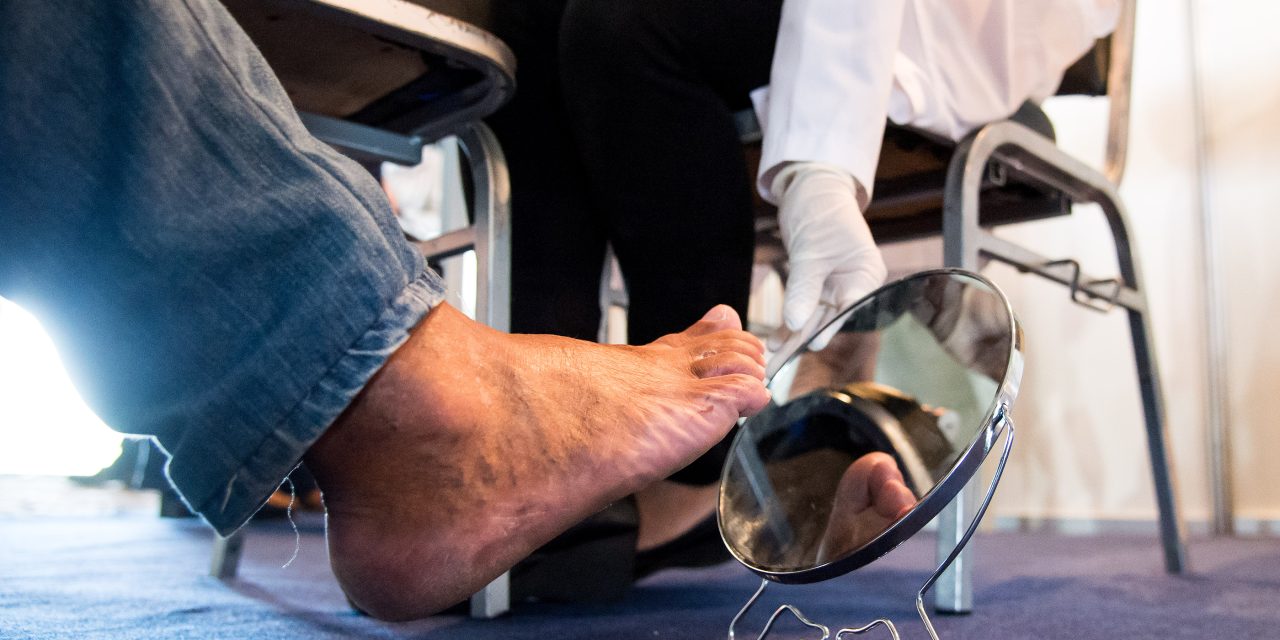Diabetic neuropathy is a common complication of diabetes that affects millions of people worldwide. It occurs when high blood sugar levels damage the nerves, leading to various symptoms such as pain, numbness, and tingling in the affected areas. Timely intervention and proper management are essential to prevent worsening of the condition and maintain a good quality of life.

The treatment of diabetic neuropathy involves a combination of medical interventions, lifestyle modifications, and alternative therapies to manage symptoms and prevent further complications. It is crucial for patients and healthcare providers to work together to develop an individualized treatment plan that addresses each patient’s unique needs and goals.
Key Takeaways
- Diabetic neuropathy is a nerve-damaging complication of diabetes requiring medical and lifestyle interventions
- Individualized treatment plans are essential for managing symptoms and preventing complications
- A combination of medical treatments, home remedies, and alternative therapies can help improve quality of life
Understanding Diabetic Neuropathy
Defining Diabetic Neuropathy
Diabetic neuropathy, a common complication of both type 1 and type 2 diabetes, refers to nerve damage caused by prolonged high blood sugar levels. It affects various nerves in the body, and hence, presents diverse symptoms and types. Some of the primary forms of diabetic neuropathy include:
- Peripheral neuropathy: The most common form, affecting feet and legs first, followed by hands and arms.
- Autonomic neuropathy: Affects nerves controlling internal organs, causing issues with digestion, sexual function, heart rate, and blood pressure.
- Radiculoplexus neuropathy: Strikes nerves in the thighs, hips, buttocks, or legs, causing pain and weakness.
Causes and Risk Factors
The primary cause of diabetic neuropathy is chronic high blood sugar levels. This damages nerves and impairs their ability to transmit signals. Specific risk factors that could augment the chances of developing diabetic neuropathy include:
- Long-standing diabetes
- Kidney disease
- Smoking
- Obesity
- High blood pressure
- High cholesterol levels
Symptoms and Diagnosis
Depending on the type of neuropathy, symptoms may differ. Some common symptoms encountered in diabetic neuropathy patients include:
- Numbness, burning or tingling sensations in the extremities
- Difficulty regulating blood pressure and heart rate
- Dizziness and lightheadedness
To diagnose diabetic neuropathy, a doctor may adopt the following methodologies:
- Physical examination: To check sensitivity to vibration, touch, and temperature.
- Autonomic testing: To assess nerve activity in response to stimuli.
- Nerve conduction studies: To measure electrical activity in the nerves.
- Quantitative sensory testing: For responses to pressure and temperature.
Preventing diabetic neuropathy requires proper management of blood sugar levels, blood pressure control, and adopting a healthy lifestyle that includes maintaining a balanced diet and regular exercise.
Medical Treatments
Medications for Pain Management
Several medications can be used to help manage the pain associated with diabetic neuropathy. Some of the most common categories include:
- Antidepressants: Specifically, tricyclic antidepressants (TCAs) and serotonin-norepinephrine reuptake inhibitors (SNRIs) can be effective in reducing nerve pain. Examples include amitriptyline, nortriptyline, duloxetine, and venlafaxine.
- Anticonvulsants: Originally designed to treat seizures, medications like gabapentin, pregabalin, and carbamazepine have shown effectiveness in treating diabetic neuropathy pain.
- Opioids: Although not recommended as a first-line treatment due to the risk of dependence, opioids such as tramadol and oxycodone may be prescribed for severe neuropathic pain.
- Topical treatments: Over-the-counter creams and gels, such as capsaicin and lidocaine, can provide temporary relief for localized pain related to diabetic neuropathy.
Controlling Blood Glucose Levels
Properly managing blood glucose levels is key to both preventing and treating diabetic neuropathy. Some important steps include:
- Monitoring: Regularly check blood glucose levels and consistently logging the results.
- Nutrition: Consuming a balanced diet low in simple sugars and rich in fiber, protein, and healthy fats.
- Exercise: Engaging in regular physical activity to help maintain or improve blood glucose control.
- Medication: Taking prescribed medications like insulin or oral glucose-lowering medications as directed by a healthcare professional.
Therapeutic Procedures
Some therapeutic procedures may help alleviate pain and improve mobility in individuals with diabetic neuropathy. Common treatments include:
- Physical therapy: A physical therapist can work with patients to develop an exercise plan tailored to their needs and abilities, potentially improving mobility and balance.
- Transcutaneous electrical nerve stimulation (TENS): This non-invasive therapy involves the application of electrical impulses to the affected area, reducing pain signals. TENS devices can be portable and used at home.
- Plasma exchange and intravenous immune globulin (IVIG): These treatments are reserved for severe neuropathy cases and involve filtering harmful antibodies from the blood or providing a dose of healthy antibodies, respectively.
Remember that the effectiveness of these treatments may vary from person to person, and it is important to consult with a healthcare professional to discuss the most suitable options for managing diabetic neuropathy.
Lifestyle and Home Remedies

Dietary Changes
A well-balanced diet can play a significant role in managing diabetes neuropathy. It’s crucial to maintain stable blood sugar levels. Some suggestions include:
- Carbohydrates: Opt for complex carbs like whole grains, legumes, and vegetables. Limit refined carbs and sugar intake.
- Protein: Choose lean sources of protein such as fish, poultry, and plant-based proteins.
- Fats: Focus on healthy fats like avocados, nuts, and olive oil. Limit saturated and trans fats.
Consuming fiber-rich foods and staying hydrated are also essential for overall health and blood sugar management.
Exercise and Physical Therapy
Regular physical activity can help improve circulation, blood sugar control, and muscle strength, all of which are beneficial in managing neuropathy. Patients should aim for at least 150 minutes of moderate-intensity exercise per week.
Some suitable exercises include:
- Walking
- Swimming
- Cycling
- Tai Chi
Physical therapy may also help with pain and mobility issues. Consult with a therapist to develop a personalized exercise plan tailored to individual needs and abilities.
Foot Care
Proper foot care is vital for preventing complications such as ulcers and infections. Follow these daily care tips:
- Inspect feet: Check for cuts, blisters, and swelling. Use a mirror or ask for assistance if necessary.
- Wash feet: Use warm water and mild soap, drying them thoroughly.
- Moisturize: Apply a foot cream or lotion to prevent dry skin and cracking.
- Trim nails: Cut toenails straight across and file edges.
- Wear appropriate footwear: Choose supportive, well-fitting shoes and clean, well-fitting socks.
Remember to consult a healthcare professional for regular foot checkups and follow their recommendations for optimal care.
Alternative Therapies

Supplements and Vitamins
Some supplements and vitamins can be beneficial in managing diabetic neuropathy. It is important to consult with your healthcare professional before starting any supplement regime. A few options include:
- Alpha-lipoic acid (ALA): This antioxidant has shown potential in reducing neuropathy symptoms. A suggested dose is 600-800 mg per day (divided into smaller doses).
- Vitamin B12: Often deficient in people with diabetes, taking a B12 supplement can help improve nerve function. Consult your healthcare provider for the recommended dosage.
- Magnesium: This essential mineral can help aid in nerve conduction and may alleviate neuropathy symptoms.
| Supplement | Suggested Dosage |
|---|---|
| Alpha-lipoic acid | 600-800 mg/day divided |
| Vitamin B12 | Consult healthcare professional |
| Magnesium | Consult healthcare professional |
Acupuncture and Massage
Acupuncture involves the insertion of thin needles into specific points on the body to improve circulation and relieve pain. Evidence suggests that acupuncture can help reduce neuropathy symptoms, making it a viable alternative therapy.
Massage can help relieve muscle tension, improve circulation and stimulate the release of endorphins. Specially designed massages for diabetics focus on releasing pressure on nerves and improving blood flow to affected areas.
Mind-Body Techniques
These techniques aim to create a harmonious balance between the mind and the body, promoting overall well-being and stress reduction.
- Relaxation Techniques: Practices such as deep breathing, progressive muscle relaxation and guided imagery can help manage stress, which has been known to exacerbate neuropathy symptoms.
- Meditation: Regular meditation has been shown to reduce pain and improve quality of life in people with chronic illness, including diabetes. It fosters relaxation and well-being, which can help manage neuropathy symptoms.
- Yoga and Tai Chi: Gentle forms of exercise, such as yoga and tai chi, can increase circulation, improve balance and flexibility, and promote relaxation. These practices have been reported to be helpful in reducing neuropathy symptoms.
Monitoring and Managing Complications

Regular Check-Ups
It is essential to ensure individuals with diabetes neuropathy receive regular check-ups with their healthcare provider. These check-ups should include:
- Blood sugar level monitoring
- Blood pressure control
- Medication adjustments
- Foot examinations
| Factors | Target Levels | Recommendations |
|---|---|---|
| Blood Sugar | A1C <7% | Check every 3-6 months |
| Blood Pressure | <140/90 mmHg | Check at each visit |
| Cholesterol | LDL <100 mg/dL | Check yearly |
By adhering to these targets, potential complications can be addressed early and managed appropriately.
Coping with Sensory Loss
One of the most common symptoms of diabetic neuropathy is sensory loss. To cope with this, individuals should take preventive measures:
- Avoid extreme temperatures to prevent burns or frostbite.
- Use footwear with proper cushioning and support.
- Be cautious when walking on rough surfaces.
- Engage in activities that promote circulation, such as exercise and massage.
Preventing Further Nerve Damage
To minimize further nerve damage, patients should:
- Manage blood sugar levels by following a healthy diet and taking prescribed medications.
- Quit smoking to improve blood flow and circulation.
- Attend physical therapy sessions to maintain muscle strength and flexibility.
- Consult with their healthcare provider to monitor and manage any other associated medical conditions.
By incorporating these practices, individuals with diabetes neuropathy can effectively monitor and manage potential complications that may arise.
Support and Resources

Support Groups
Joining a support group can help individuals with diabetes neuropathy to cope with their condition. These groups provide a platform to share experiences, learn from others, and develop a sense of belonging. Some popular support groups include:
- American Diabetes Association (ADA) support groups: find a local group
- Diabetic Connect: online community
- Neuropathy Support Network: locate a support group
Educational Materials
Educational materials can enhance understanding of diabetes neuropathy and its management strategies. Here are some reputable sources:
| Organization | Resource |
|---|---|
| National Institute of Diabetes and Digestive and Kidney Diseases (NIDDK) | Diabetic Neuropathy |
| American Diabetes Association (ADA) | Living with Diabetes: Neuropathy |
| National Diabetes Information Clearinghouse (NDIC) | Diabetic Neuropathies: The Nerve Damage of Diabetes |
Professional Counseling
Professional counseling can assist individuals with diabetes neuropathy to manage their mental well-being and adapt to the challenges posed by the condition. Some options are:
- Cognitive-behavioral therapy (CBT): focuses on changing negative thought patterns and developing healthy coping mechanisms
- Stress reduction techniques: include meditation, mindfulness, and relaxation exercises
- Referral to a counselor or psychologist: who specializes in chronic illness management
By participating in support groups, accessing educational materials, and seeking professional counseling, those affected by diabetes neuropathy can better manage and cope with their condition.
Frequently Asked Questions

What medications are effective for managing diabetic neuropathy in the legs and feet?
There are several medications that may help manage diabetic neuropathy in the legs and feet. Some common options include pain relievers, such as over-the-counter nonsteroidal anti-inflammatory drugs (NSAIDs); prescription strength pain relievers, such as tramadol or oxycodone; and medications that target nerve pain, such as gabapentin, pregabalin, and duloxetine. It’s essential to consult a healthcare provider to discuss appropriate treatments for individual cases.
Which medical specialists are qualified to treat diabetic neuropathy?
Several medical specialists can treat diabetic neuropathy. Primary care physicians, endocrinologists, and neurologists are all qualified to diagnose and manage this condition. Additionally, a pain management specialist or a podiatrist may be involved in treating neuropathy in the legs and feet.
After how much time of having diabetes does neuropathy typically develop?
The onset of diabetic neuropathy varies from person to person. Some individuals may develop neuropathy within a few years of living with diabetes, while others may not experience symptoms for several decades. Factors that can influence the development of neuropathy include blood glucose control, duration of diabetes, and personal genetics.
Is Pregabalin an effective treatment option for diabetic neuropathy?
Yes, pregabalin is an effective treatment option for diabetic neuropathy. It is an FDA-approved medication for this condition, and clinical trials have shown that it can help reduce pain and improve sleep quality in individuals with diabetic nerve pain. As with any medication, it’s essential to discuss the benefits and potential side effects with a healthcare provider.
What are the steps involved in diagnosing diabetic neuropathy?
Diagnosing diabetic neuropathy involves several steps. A healthcare provider will typically start by reviewing the patient’s medical history, performing a physical examination, and evaluating their symptoms. Additional tests may be ordered, such as nerve conduction studies, electromyography, or quantitative sensory testing, to assess nerve function and confirm the diagnosis.
Can lifestyle changes lead to the reversal of neuropathy caused by diabetes?
Lifestyle changes can help manage and sometimes improve neuropathy caused by diabetes, but it is not always reversible. Maintaining healthy blood glucose levels, exercising regularly, and adopting a balanced diet can help slow the progression and alleviate symptoms. In some cases, significant improvements in blood sugar control and lifestyle habits may lead to a reduction in neuropathy symptoms. However, it is crucial to work closely with a healthcare provider when implementing any lifestyle changes for managing diabetic neuropathy.
















